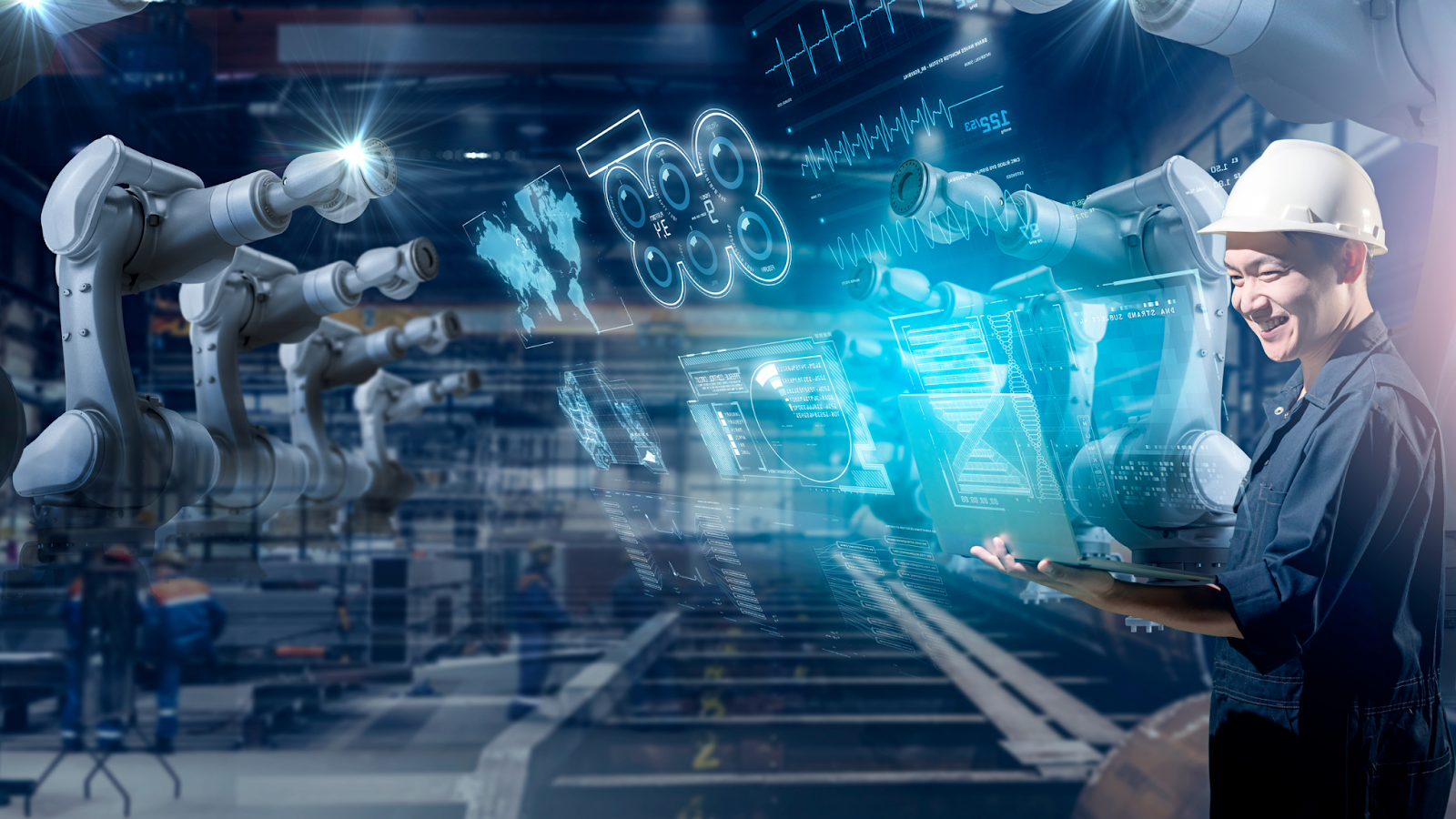What is "Smart Factory"? The most outstanding feature in Smart Factory that you need to know
What is “Smart Factory”?
"Smart Factory" is a digitized manufacturing facility that uses connected production devices, machines, and systems to continuously collect and share data. This data is then used to inform process improvement decisions as well as to resolve any issues that may arise.
The smart manufacturing methods used by a smart factory are enabled by a variety of technologies including artificial intelligence (AI), big data analytics, cloud computing, and the Industrial Internet of Things (AI). Iodine).

The smart factory has good interaction in real time in both directions between the layers, from the strategy layer to the management layer, the operations layer and the machinery layer.
Another concept reference from Deloitte Insights: The smart factory is a dramatic evolution from a traditional automated production system to a flexible, connected manufacturing plant. As a result, production and business activities will be more efficient, more flexible, reduce downtime, and have the ability to predict and self-adjust.
The most outstanding feature of Smart Factory
Smart factory solution is an effective arm for the production process of enterprises. All activities are carried out oriented and throughout the entire value chain, this contributes to controlling QCD (Quality – Quality, Cost – Cost, Delivery – Progress), helping to improve advantages competition of enterprises, increasing opportunities to enter international markets. Let's learn through 12 most prominent features of the smart factory model right below:
- Automation: Contributing to the success of the smart factory cannot ignore the system of advanced machinery, industrial robots and self-propelled AGVs. These tools form an automatic production process that minimizes human involvement in the operation and production process.
- Smart: RFID sensor, QR code scanning device, etc. Smart devices are absolutely applied to collect data in real time of the production and operation process. They are present at every stage, in every corner (productivity management, goods location, warehouse, logistics, etc.)
- Connectivity: This is the most important feature that sets the smart factory apart from the old factory models of the previous Industrial Revolution. In which, IoT (internet of things) is considered as the backbone in the data flow between layers. Combined with OPC - UA (multi-platform protocol) makes the communication between machines - software easy to support for monitoring - production management purposes. As a result, each enterprise can connect and process data continuously to provide a holistic view, driving overall network efficiency higher than ever.

- Real-time: Creating a connection flow between machines - equipment - people has created a true smart factory with management and monitoring all easily recorded in real time.
- Visualization: The smart factory effectively communicates information to stakeholders through graphical means. Data from lines and machines is recorded and transmitted immediately to the industrial tablet system (large digital screen). Visualization is also applied to the entire operating system, remote monitoring and control in real time.
- Digitization: MES system & ERP system are two indispensable technology platforms, they help digitize the entire core management process and operations in the factory. From there, the production data becomes consistent, contributing to the addition of other features more clearly and effectively.
- Proactive: Without complete initiative, the smart factory represents an improved form of factory, which is increasingly more proactive and efficient than the factories of the old industrial stage. The thorough application of forecasting and planning activities in the process of quality management, material management, maintenance, etc. has made the smart factory worthy of becoming a model for industry 4.0.
- Flexibility: The smart factory solution is always ready to adapt, responding to any changing operations in terms of physical (factory layout), requirements for balancing production capacity and lead time even when faced with market fluctuations.
- Comprehensive: Smart reporting system (Business Intelligence) is applied to transform the collected data throughout the factory to create visual slice charts of the entire production and business activities. This creates a big picture, helping managers to operate and strategize easily and quickly.

- Optimization: All the above characteristics are the premise to create the optimization of a smart factory. Where there is outstanding strength not only in capacity and quality but also in the ability to optimize all aspects of business and production activities of enterprises.
Benefits of Smart Factory
- Smart factories use connected equipment to enable statistical decision-making to optimize efficiency and productivity throughout the production process.

- Delivering a fast, iterative manufacturing process can expand the capabilities of both equipment and employees, resulting in lower costs, reduced downtime, and less waste in the manufacturing industry.
- Identify and then reduce or eliminate manufacturing possibilities that are misused or misused. Thereby increasing the ability to invest in new resources.
- The benefits of digitizing a factory include those related to planning, quality control, product development, and logistics as each is evaluated and optimized based on feedback. actual return.
- There are also long-term benefits to be gained through embedding machine learning in the process. By collecting and analyzing data, it is possible to schedule predictive and preventive maintenance - based on accurate real-life information - to avoid production line downtime.
Four levels of smart factories
There are four levels that can be used to gauge your journey through the improvement process to becoming a smart producer:
Level 1: Available data
At this level, a factory or facility isn't really 'smart' at all. Data is available but not easily accessed or analyzed. Analyzing the data, where it is done, is time-consuming and can cause inefficiencies in the manufacturing process.
Level 2: Accessible data
At this level, data can be accessed in a more structured and understandable form. Data will be provided centrally and organized with visualizations and visualizations that aid processing. All this allows for proactive data analysis, although there will still be certain limitations.
Level 3: Working data
At this level, data can be analyzed with the help of machine learning and artificial intelligence, generating insights without much human supervision. The system is more automated on the second level and can predict major problems or anomalies to proactively predict potential failures.
Level 4: Actionable data
Level four builds on the active nature of level three to create solutions to problems and, in some cases, take action to alleviate a problem or improve a process. without human intervention. At this level, data is collected and problems are analyzed before solutions are created and, where possible, done with very little human input.

Conclude
Smart factories use a range of different technologies to create connected manufacturing, capable of collecting and evaluating process data, and delivering improvements in efficiency, safety and more than that.
This optimization can include procedural improvements, inspection and maintenance improvements, logistics, timing and even staff utilization.
Using the Internet of Things along with data analytics and sensors, a smart factory can become an active part of the process towards Industry 4.0, with improvements felt throughout the entire manufacturing process. export.
However, with the high costs of upgrading equipment, setting up safety systems and retraining employees, not every organization can guarantee it. It is even more difficult to commit to an upgrade that goes hand in hand with the benefits it brings.
The decision to build a smart factory needs to involve all areas of the company, but ultimately needs to be based on an accurate comparison of whether it is worthy of a particular facility or business model. your body or not.
CMC TS is the leading unit in Vietnam in consulting and implementing solutions to build smart factories such as MES, smart identification solutions, asset management or IOT,... With many years of experience With experience in the profession, we are committed to providing customers with quality service packages at the best prices in the market. In addition, we also have a team of highly qualified and experienced technicians, ready to support you 24/7.
To understand this and be able to make the best decision for your organization, please register for a consultation from the CMC TS team in the form below.







